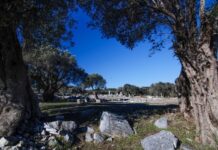How was it that the image of the serpent worked salvation to the people in distress? Would it not have been more reasonable to say, “If any of you be bitten, let him look up to heaven, to God, and he shall be saved, or let him look towards the tabernacle of God”? Passing over this, he set up the image of the Cross alone. Why did Moses do this, who said to the people, “Thou shalt not make to thyself a graven thing, nor the likeness of anything that is in heaven above, or in the earth beneath, nor of those things that are in the waters under the earth”? (Ex. 20.4)
However, why do I speak to unworthy people? Tell me, devout servant of God, will you do what is forbidden, and disregard what you are told to do? He who said, “Thou shalt not make to thyself a graven thing,” condemned the golden calf, and you make a brazen serpent, and this not secretly, but most openly, so that it is known to all. Moses answers, I laid down that commandment in order to root out impiety, and to withdraw the people from all apostasy and idolatry; now, I have the serpent cast for a good purpose–as a figure of the truth.
Preliminary to the image of the Cross
And just as I have put up a tabernacle, and everything in it, and cherubim, the likeness of the invisible powers, over the holy of holies, as a sign and figure of the future, so I have set up a serpent for the salvation of the people, to serve as a preliminary to the image of the Cross, and the redemption contained in it. As a confirmation of this, listen to the Lord saying, “As Moses exalted the serpent in the desert, so must you exalt the Son of Man, that every one believing in Him may not be lost, but may have eternal life.” (Jn. 3.14)
Commentary.-Notice that His commandment not to make any graven thing was given to draw the people from idolatry, to which they were prone, and that the brazen serpent was an image of our Lord’s suffering.
Listen to what I am going to say as a proof that images are no new invention. It is an ancient practice well known to the best and foremost of the fathers.
Elladios, the disciple of blessed Basil and his successor, says in his Life of Basil that the holy man was standing by the image of Our Lady, on which was painted also the likeness of Mercurius, the renowned martyr. He was standing by it asking for the removal of the impious apostate Julian, and he received this revelation from the statue. He saw the martyr vanish for a time, and then reappear, holding a bloody spear.
Read More about Apologia of St John Damascene Against those who Decry Holy Images Part 37








